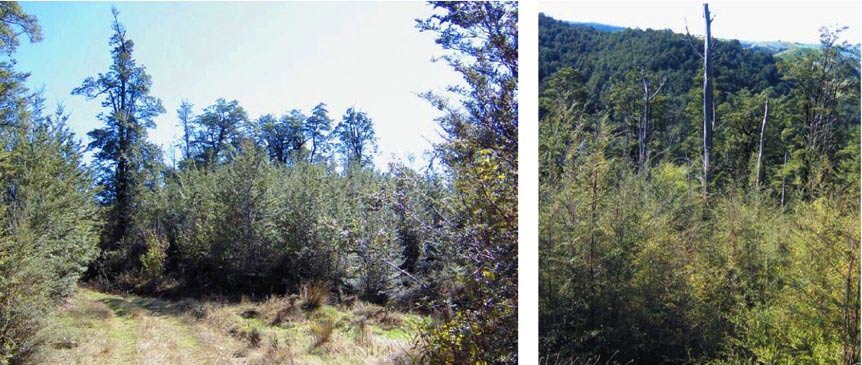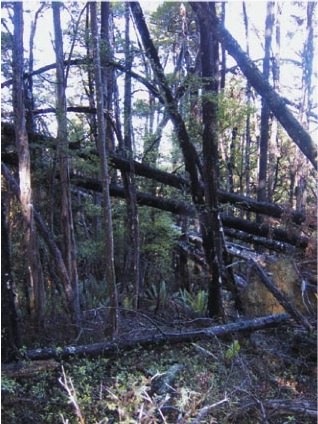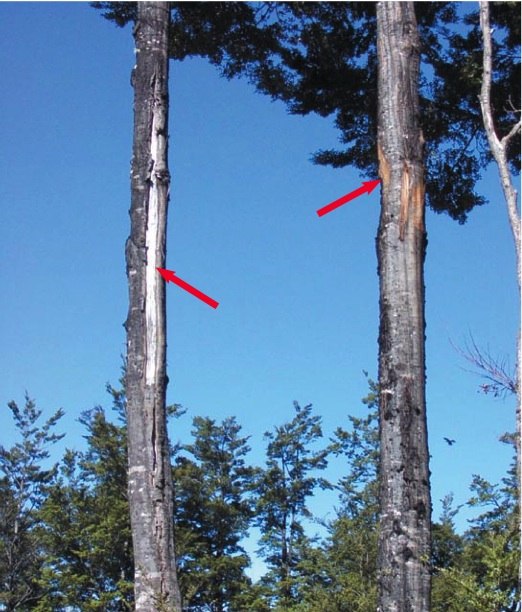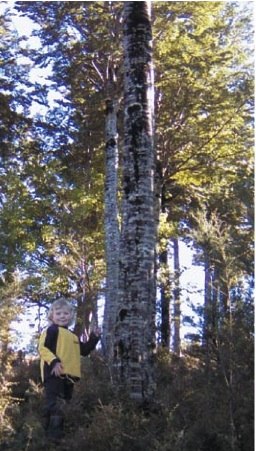Black beech management
John Wardle, New Zealand Tree Grower November 2005.
Rosalie and I purchased a property near Oxford in the Canterbury foothills in 1973. This property had about 84 hectares of black beech regrowth, mostly dating from the 1930s, which we subsequently attempted to manage for the production of timber. We attempted a number of silvicultural regimes which we felt were appropriate at the time. Some failed dismally, but others showed greater promise.
By a process of adaptive management, we are now reaching the stage where we are more or less happy with the regime we have adopted. However we have no doubt that in the future, some of our practices will evolve as a result of an increased understanding of the species we are dealing with.
One thing has become increasingly apparent. It is that the successful development of a silvicultural regime depends on an intricate knowledge of the ecology of black beech, particularly on the interaction between the ecology and climate.
Ecological characteristics
Seed production and regeneration
Our New Zealand beeches, in common with their northern hemisphere counterparts, show a great variation in seed fall from year to year. In some years seed production is prolific. These are known as mast years and in black beech they average about five to eight years apart. In the intervening years there may be very little seed produced which is frequently not viable. Beech gets over this problem by having a stock of young advance-growth seedlings on the forest floor which may sit there for 20 years or more while making minimal growth.
When an opening occurs in the canopy as a result of windthrow or death of a mature tree, these respond to the increased light reaching the forest floor by making rapid growth, often as much as half a metre a year. When these grow to be saplings of between two and three metres in height there may be more than 100,000 of them for every hectare. These compete strongly with each other and suppress most understorey plants.

Left to their own devices they will grow slowly to become a pole stand of tall, closely spaced individuals. When the average diameter is around 20 cm, competition will have reduced the number to between 5,000 and 10,000 stems per hectare. These closely spaced stems are supported by very small root plates, which have little in the way of deep anchorage.
An exception to this pattern occurs on lower slopes with deep, well drained soils. Usually on these sites there is a dense fern cover. This fern cover inhibits the establishment of beech seedlings so that stocking rates tend to be relatively low. The reduced competition, combined with the better soils, leads to much faster growth rates.
Wind as a factor in stand development

New Zealand beeches have evolved to cope with frequent disturbance. In our case, wind is the predominant factor controlling the behaviour of natural stands. The typical life of black beech stands, particularly regrowth stands such as we have inherited, is that once they reach the pole stage they become increasingly vulnerable to wind. The tall stems with small root systems have little support apart from that mutually provided by close neighbours. Eventually a gap is formed, and subsequent storms work on that gap until a reasonably large area becomes flattened.
This susceptibility to wind does not affect the survival of the species, as the disturbed soil provides the ideal medium for seedlings to germinate and become established. Black beech regenerates profusely on these sites. An even-aged thicket of saplings and poles develops, which in turn becomes susceptible to wind and the whole process is repeated.
Due to the influence of fern cover as mentioned earlier, and its inhibiting influence on black beech regeneration, stands developing on deeper soils on the lower slopes are less vulnerable to wind. There is a tendency on these sites towards the development of mixed-aged forest.
The influence of exposure
The exposed bark of saplings, and young trees still with smooth bark, tend to be particularly vulnerable to the desiccating effect of sunshine and hot dry winds. Frequently on the northerly side of exposed stems, cambial death results and this is followed by the invasion of fungal species into the wound. The resultant rot weakens the stem, and these subsequently collapse usually damaging other stems as they fall. These also develop rot as a result of this damage. This gives rise to a domino effect so that on occasions all stems on the outer 10 to 20 metres from a stand margin may ultimately be damaged. Pruning edge trees on an exposed stand margin usually increases the potential for such damage.
Winter desiccation, as distinct from frosting, can also be detrimental to healthy stand development. This condition, which results from a combination of cold soils and wind, is most prevalent in saplings up to five metres in height. The cold soils restrict the uptake of water and the influence of wind on the foliage leads to a droughting effect and subsequent death of tops, or even the total death of the stems. The problem is most prevalent on gentle slopes where cold air drainage is impeded, and is particularly severe where the young stands are even-aged. In some cases all of the stems may be affected.
The silvicultural regime
The ecological properties of black beech that are fundamental to the development of a silvicultural regime are –
- Prolific natural regeneration on to bare mineral soils following disturbance
- Inhibiting influence of dense fern ground cover on the establishment of black beech seedlings
- Vulnerability of natural pole stands to wind damage
- Susceptibility of saplings and young trees to exposure.

Development of a mosaic
Under the Forest Amendment Act 1993, there is a prescription that ‘beech and other light demanding hardwood species be harvested only in coupes of 0.5 hectares or less’. In other words, it is decreed that a group selection silvicultural system be adopted whereby all stems are removed within particular defined harvest areas. This promotes the development of a mosaic of small even-aged stands, varying in size dependant on the area of the coupe selected.
Group selection was therefore the silvicultural system we initially adopted, and we set our coupe limits at between 0.05 and 0.15 hectares. One of the factors in the selection of coupes for harvest was that advance growth was already present on the forest floor, therefore reducing any delays in regeneration relating to the irregularity of mast years.
On the lower slopes it was often necessary to remove dense fern cover to expose mineral soil so that adequate beech regeneration could be achieved. The fern was grubbed out in one metre diameter circles at three metre intervals several years before harvest in order to pre-empt mast years.
Advantages and disadvantages of group selection
The group selection system certainly has positive attributes. Removal of wood at harvest time, and subsequent silvicultural operations, is concentrated on finite areas. Ground based extraction is consequently cheaper and more feasible than with more intricate selection systems. The coupe pattern mimics the windthrow pattern which occurs naturally in the forest. It could therefore be claimed that we had adopted a nearly natural harvesting system.
However some pronounced disadvantages became apparent after a few years. The size of coupes was such that wind and exposure factors had a deleterious impact on the surrounding stands. Coupes which were originally around a tenth of a hectare in area sometimes became expanded to half a hectare or more. The even-aged regeneration developing on these coupes progresses through to dense pole stands. Therefore the unstable conditions leading to a high potential for wind damage are perpetuated, and winter desiccation on certain sites can cause unacceptable levels of deformity and death in regenerating stands.

Mosaic of saplings and poles
As a result of natural damage to the forest from wind, and by the creation of coupes associated with the initial adoption of the group selection system, perhaps as much as half our forest area is now composed of a mosaic of even-aged groups of saplings and poles. Our present management of these even-aged stands is designed to reduce the long term potential for wind damage, and at the same time, minimise winter desiccation and cambial scorching effects.
Progressive thinning is initiated once young stands reach a height of between four and five metres. This is usually at about age 12, and concurrently pruning is undertaken to about half stem height. About 800 to 900 stems per hectare are selected on the basis of spacing, form and vigour. Around each tree all competing woody vegetation is removed within a circle with a radius of a metre. Any vegetation outside this circle is left to protect selected stems from potential exposure damage.
The removal of the competing vegetation allows for the unrestricted development of an expanding root system and potentially greater long term wind stability. Further root extension is promoted when the stand reaches seven to eight metres in height at about age 16. The radius for removal of competing vegetation is then extended to 1.5 metres, doubling the root space available. At the same time final pruning is undertaken to between four and five metres. Sufficient protection still remains to negate exposure effects.
The ultimate harvesting size
Further thinnings are carried out until a final crop stocking of 450 stems per hectare remains. The aim is to harvest the selected stems when they reach a diameter of 45 cm. Indications are that the time taken to reach this size will be at about 50 years.
For the remaining forest, any areas that blow down in future will be harvested and the regeneration treated as above. Elsewhere stems are harvested when they reach 45 cm diameter regardless of whether they occur singly or in groups. Regeneration into the small gaps formed are thinned and pruned, but there is not the same need to protect the selected stems from the exposure effects since the surrounding wood provides this function.
The reason for selecting 45 cm as the ultimate harvesting size relates to the incidence of defect in the stems. Up to 45 cm, diameter growth rates can be very rapid, provided appropriate silvicultural systems are employed and stem defect, given protection from exposure, is minimal. However, beyond this size growth rates tend to slow down and there is often an increase in the incidence of stem rot and other defects.
John Wardle is a recognised authority in black beech ecology and management.

 Farm Forestry New Zealand
Farm Forestry New Zealand